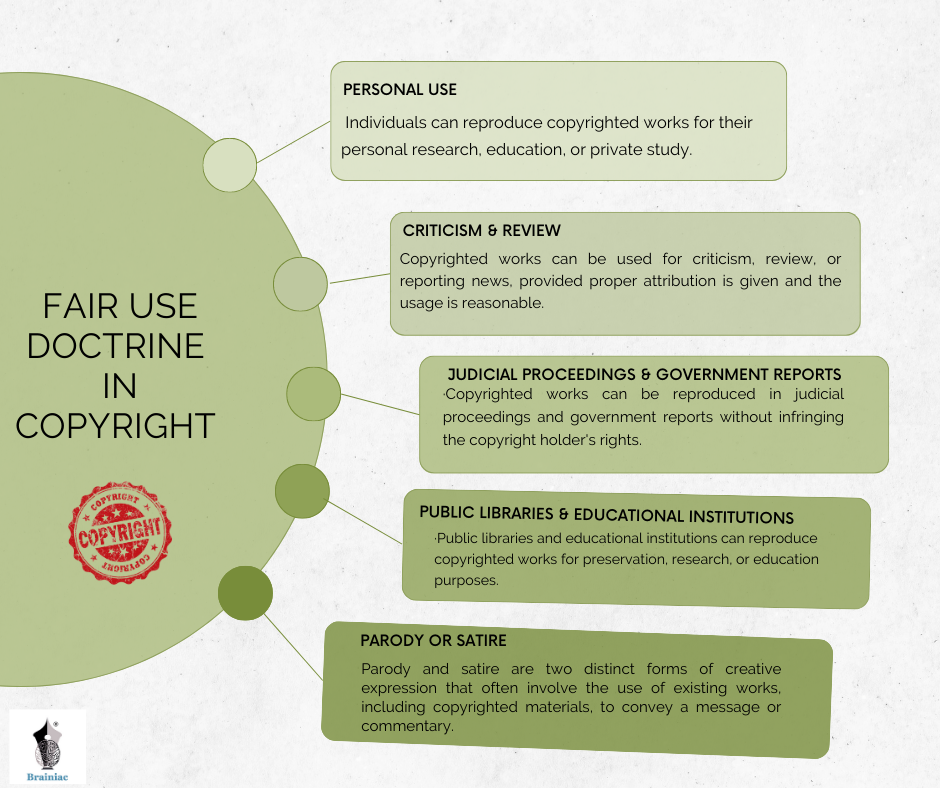Introduction
In the digital age, where information flows freely and creative works are easily accessible, copyright law plays a pivotal role in protecting the rights of creators and fostering a balance between innovation and public access. The Indian Copyright Act of 1957 stands as a robust framework for safeguarding these rights. Under Section 52 of the Act, the fair use doctrine is a critical component that allows limited use of copyrighted materials without infringing upon the rights of creators. In this article, we delve into the intricacies of the Indian fair use doctrine, explore its provisions, and elucidate its application.
Understanding Fair Use Doctrine
Copyright law grants creators’ exclusive rights over their original works, such as literary, artistic, musical, and dramatic creations, giving them the authority to reproduce, distribute, and adapt their works. However, these rights are not absolute. The fair use doctrine, often referred to as fair dealing in India, provides exceptions to copyright infringement in cases where limited use of copyrighted materials is justified for purposes such as criticism, review, news reporting, research, education, and parody.
Legal Framework for Fair Use
In the global landscape of intellectual property rights, the concept of fair use is not only a domestic concern but also finds resonance in international agreements. Article 13 of the TRIPS (Trade-Related Aspects of Intellectual Property Rights) provides a pivotal foundation for the fair use doctrine. This article explicitly dictates that member nations must limit exceptions or limitations to exclusive rights only in specific and exceptional cases. These cases should not conflict with the normal exploitation of the work and should not unreasonably undermine the legitimate interests of the right holder.
Similarly, Article 9(2) of the Berne Convention echoes this sentiment, asserting that exceptions to exclusive rights must be permitted in certain special cases that do not impede the normal exploitation of the work and do not unduly prejudice the rights holder’s legitimate interests.
Indian Copyright Act and Fair Use
Section 52 of the Indian Copyright Act, 1957, provides a comprehensive framework for fair use of copyrighted work. This section enumerates specific circumstances in which the use of copyrighted material, even without the permission of the rights holder, is considered fair and permissible. These instances encompass activities that balance the rights of creators with the broader needs of society. Section 52 aligns itself with the principles articulated in international agreements such as TRIPS and the Berne Convention.
Section 52 of the Indian Copyright Act outlines the following instances where copyrighted works can be utilized without infringing upon the creator’s rights:
Personal Use: Individuals can reproduce copyrighted works for their personal research, education, or private study.
An avid history enthusiast purchases a copyrighted ebook about ancient civilizations. They print out certain chapters to read and annotate for their personal research and enrichment. Since this usage is for personal study and not for distribution, it falls under the exception of personal use.
Criticism and Review: Copyrighted works can be used for criticism, review, or reporting news, provided proper attribution is given and the usage is reasonable.
A film critic wishes to analyse a recently released movie. They write a detailed review that includes references to specific scenes, dialogues, and characters from the film. This use of copyrighted material is justifiable under criticism and review, as it contributes to a thoughtful analysis and adds value to the public discourse about the film.
Judicial Proceedings and Government Reports: Copyrighted works can be reproduced in judicial proceedings and government reports without infringing the copyright holder’s rights.
In a court case involving copyright infringement, the plaintiff presents excerpts from a copyrighted book as evidence of the alleged infringement. Since the use is directly related to the legal proceedings and is not intended for commercial gain, it is considered permissible within the scope of judicial proceedings.
Public Libraries and Educational Institutions: Public libraries and educational institutions can reproduce copyrighted works for preservation, research, or education purposes.
A public library wishes to create a digital archive of classic novels. The library scans and digitizes these novels to make them accessible to the public for educational and research purposes. By doing so, the library ensures the preservation of literary heritage and provides a valuable resource to the community.
Parody and Satire:
A talented comedian decides to create a parody of a popular song to provide a humorous commentary on a social issue. The fair use doctrine permits the use of portions of the original song for transformative purposes, like parody, as long as the new creation does not act as a substitute for the original and serves a distinct purpose.
Conclusion
Section 52 of the Indian Copyright Act outlines the fair use doctrine, which strikes a delicate balance between the protection of creators’ rights and the promotion of innovation, education, and public discourse. By permitting limited use of copyrighted materials in certain contexts, the fair use doctrine encourages creativity and promotes the growth of a knowledge-based society without unduly restricting access to information. When invoking the fair use doctrine, individuals and organisations must exercise caution and adhere to the principles of fairness and proportionality. This strategy protects the rights of creators while fostering an environment that encourages artistic expression and the exchange of ideas.



